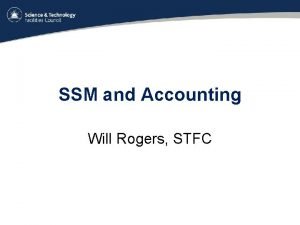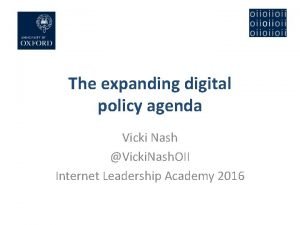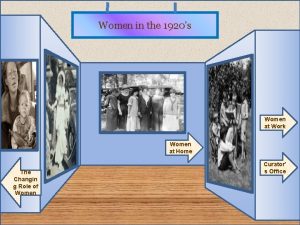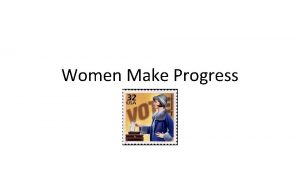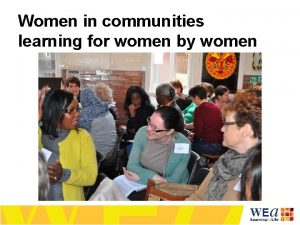IT Women Vicki Rogers vickiruga edu vicki rogersoit





































- Slides: 37

IT Women Vicki Rogers vickir@uga. edu vicki. rogers@oit. gatech. edu

Who Am I? Why Am I Here?

IT Careers Good news… • IT careers are among the 10 fastest growing US occupations • By 2026 there will be 3. 5 million computing related job openings But… • At the current rate only 17% of those jobs could be filled by computing bachelor’s degree recipients.

What Percentage of US Professional Employees are Women? 57%

What Percentage of US IT Employees are Women? • Women made up 26% of IT employees (2017) – 3% African American women – 5% Asian women – 1% Hispanic women • Down from 35% in 2002 • And 41% in 1996

Women in Big IT Companies • Google’s workforce is only 30% female – Only 17% of tech jobs • Yahoo 37% • Facebook 31% – Only 15% are tech jobs • Linked. In 39% • Twitter 50% – Only 10% are tech jobs

What Percentage of US IT Managers are Women? • US Bureau of Labor and Statistics say 30% of IT managers are women • Educause says 23% of Higher Education CIOs or senior managers are women • 7% CIOs were women in 2014, this declined 2% from 2 years earlier • In 2016, 43% of the 150 highest earning public companies had NO female officer at all

Not Just an IT Problem • Women occupy less than 20% senior leadership positions across the public and private sectors • In politics, women constitute over ½ the voting public, but only – 19 % of Congress – 12 % of governors – 19 % of mayors of the nation’s one hundred largest cities. • From a global perspective, the US ranks 97 th in the world for women’s representation in political office, below Slovakia, Bangladesh, and Saudi Arabia

Not Just an IT Problem • In academia, women account for a majority of college graduates and post-graduate students but only about ¼ of full professors and university presidents • In law, women are almost ½ of law school graduates but only 18 % of the equity partners of major firms, and 21 % of Fortune 500 general counsels • In the nonprofit sector, women constitute ¾ of staff positions but only 1/5 the leaders of large organizations

Not Just an IT Problem • In business, women account for 1/3 of MBA graduates, but only 4 % of Fortune 500 CEOs • At current rates of change, it could take more than a century for women to reach parity in the C suite


The IT Difference The numbers of women are gradually increasing in every profession and leadership level EXCEPT IT

My Research What’s going on? Does it matter? How do we fix it?

University System of Georgia • 28 public institutions all over the state • Governed by a Board of Regents • 325 k students • 158 k employees

USG Women 2014 • 20/30 institutions responded • Overall 30% women • 2/30 (7%) institutions have female CIOs or similar role Women 30% Men 70%

USG Women 2017 • 17/28 institutions responded • Overall 22% women (down 8% from 2014) • 3/28 (11%) institutions have female CIOs or similar role [CATEGORY NAME] [VALUE]



Why? !? ! Input Throughput

Input • 57% of all bachelors degrees are earned by women • 19% of CS degrees (It was 37% in 1985) • 56% of AP test takers are female • 47% of AP Calculus test takers were female • 23% of AP CS test takers were female

Input Considerations • 69% of girls surveyed say they’d never consider a job in IT because they don’t even know what opportunities are available • Boy parents more aggressively introduce technology than girl parents • No women role models • There’s a perception that IT is a “lifestyle” not just a job • There’s evidence that by first grade children associate math with boys • Personal computers were originally marketed as a toy for boys

Throughput Women are 2 -3 x more likely to leave IT

Throughput Considerations Organizational practices – – – Masculine work environments Hiring and promotion practices Lack of role models and mentors Stereotypes Inflexible work policies Family issues Personal barriers – Confidence and personal self worth (believe that you can succeed) – Lack of social capitol (relationships) – Networking opportunities – Sense of belonging

Elephant in the Valley Research • 200 Women with at least 10 years experience • Focused on five areas: Feedback & Promotion, Inclusion, Unconscious Biases, Motherhood, and Harassment & Safety • 84% told they are too aggressive • 66% felt excluded from key social/networking opportunities • 88% experienced male peers being questioned when it should have been them • https: //www. elephantinthevalley. com

Throughput Considerations • Great progress in overt bias – no more Mad Men • Still challenges with unconscious, implicit, or second generation bias – Invisible barriers – Unconscious Bias • 40 bits our 11 million bits • 99. 99999% unconscious thoughts – Historical/Cultural beliefs about gender • Stereotypes (note taking, hospitality) • Positive vs negative perceptions of the same behavior – Project Implicit, Harvard – Google’s Unconscious Bias Training • Still challenges with institutional bias – Workplace structure – Lack of role models – Tokenism

What’s going on? Does it matter? How can we fix it?

Does It Matter? Gallop Poll found that diverse teams perform better – Men and women have different viewpoints, ideas, and market insights, which enables better problem solving – A gender-diverse workforce provides more knowledge – A gender-diverse workforce allows the company to serve an increasingly diverse customer base – Gender diversity helps companies attract and retain talented women. Companies cannot afford to ignore 50% of the potential workforce and expect to be competitive in the global

How Does It Matter? • Improved Performance – Diverse teams make decisions 60% faster • Higher Returns – US companies with diverse boards have a 95% higher ROE than those with homogenous boards • Improved Morale and Engagement • Larger Talent Pool • Legal Protection

What’s going on? Does it matter? How can we fix it?

How Do We Fix It? Talk about it Learn more Men have to be involved Top down discussions, promotion, commitment Acknowledge that it is a critical business concern • Specifically develop women (it is different) • Institutional and Unconscious Bias Training • • •

Where Do We Start? Address these organizational issues (everyone’s responsibility): – Cultural fit – Expectation gaps – Lack of role models and mentors – Career satisfaction – Organizational commitment – Role ambiguity – Role conflict

Where Do We Start? Work on these personal barriers (women’s responsibility): – Personal self worth and believe that you can succeed – Social capitol (relationships) – Networking opportunities – Sense of belonging

The Rooney Rule

The Rooney Rule • The Rooney Rule is a National Football League policy that requires league teams to interview minority candidates for head coaching and senior football operation jobs • It was established in 2003, and variations of the rule are now in place in other industries • At the start of the 2006 season, the overall percentage of African American coaches had jumped to 22%, up from 6% prior to the Rooney Rule • The problem wasn’t that there weren’t any talented black coaches, the problem was access

The Symphony Blind orchestra auditions, with musicians behind a curtain, increased the number of female musicians hired by 25%, increasing their total to 46%


Resources • National Center for Women in Technology - www. ncwit. org • Elephant in the Valley Research - www. elephantinthevalley. com • Gender Bias in performance reviews • https: //life. saywerk. com/posts/with-these-gender-biases-at-work-even-performance-reviews-need-performance • https: //hbr. org/2017/04/how-gender-bias-corrupts-performance-reviews-and-what-to-do-about-it • Gender neutral recruiting and hiring • https: //scienceforwork. com/blog/reducing-gender-bias-hiring/ • Project Implicit https: //implicit. harvard. edu/implicit/takeatest. html • Diverse companies have higher returns https: //www. mckinsey. com/business-functions/organization/our-insights/isthere-a-payoff-from-top-team-diversity • US Bureau and Labor Statistics • Google’s Unconscious Bias Training https: //www. businessinsider. com/google-unconscious-bias-trainingpresentation-2015 -12? r=UK&IR=T#the-same-ability-now-gets-us-through-the-day-without-having-to-slowlyprocess-every-decision-we-make-4 • vickir@uga. edu • vicki. rogers@oit. gatech. edu
 Edu.sharif.edu
Edu.sharif.edu Vicki turetsky
Vicki turetsky Wvu math 150
Wvu math 150 Vicki freeman
Vicki freeman Vicki bosanko
Vicki bosanko Vicki fleming
Vicki fleming Vicki evans
Vicki evans Vicki freeman
Vicki freeman Drk juvenile center
Drk juvenile center Vicki carolin
Vicki carolin Vicki kijewski
Vicki kijewski Vicki nixon
Vicki nixon Vicki bernard
Vicki bernard Vicki lambert
Vicki lambert Vicki farnsworth
Vicki farnsworth Vicki rundle
Vicki rundle Vicki amon-higa
Vicki amon-higa Teori pembelajaran humanistik maslow
Teori pembelajaran humanistik maslow Cartoonstock.com
Cartoonstock.com This is your life roy rogers
This is your life roy rogers Fba special education
Fba special education Carl rogers potato analogy
Carl rogers potato analogy Carl rogers theory
Carl rogers theory Martha rogers teoria
Martha rogers teoria Autenticidad carl rogers
Autenticidad carl rogers Th rogers dress code
Th rogers dress code 973sm.com
973sm.com Rogers ssm
Rogers ssm Ransomware detection rogers
Ransomware detection rogers Vte protocol
Vte protocol Rogers hockey association
Rogers hockey association Th rogers ms wilkins
Th rogers ms wilkins Mr eamonn rogers urologist
Mr eamonn rogers urologist Carl rogers abraham maslow
Carl rogers abraham maslow Psychodynamic theory
Psychodynamic theory Principios psicopedagógicos
Principios psicopedagógicos Alexandra fournel
Alexandra fournel Ginger rogers measurements
Ginger rogers measurements



























